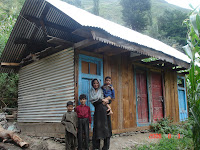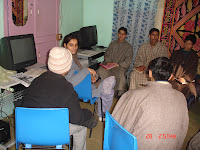Rebuilding Trust and Hope
Efforts
towards rehabilitation of earthquake affected people of Kashmir
The
border areas of Uri and Tangdar in Kashmir Valley situated close the Line of
Control on the international border between India and Pakistan suffered heavily
during the earthquake of 8 October 2005. Human lives, livestock and property
were lost. Here are glimpses of the work done by CEE under its ‘Rebuilding
Trust’ programme to help and rehabilitate the earthquake-affected people.
Psycho Social Care
for Children
Psycho-social care especially for
children was an urgent need addressed by CEE Himalaya. Programmes were
conducted in schools reaching out to more than 5000 children within a month of
the disaster. A number of teachers were also trained in psycho-social care so
they could reach out to more children.
Shelter
 Winter is very harsh as temperature
dips down to sub zero degrees. Providing shelter was the most urgent need. CEE Himalaya
provided more than 1300 interim insulated shelters in the ten worst hit
villages which helped people pass the winter comfortably.
Winter is very harsh as temperature
dips down to sub zero degrees. Providing shelter was the most urgent need. CEE Himalaya
provided more than 1300 interim insulated shelters in the ten worst hit
villages which helped people pass the winter comfortably.
All the schools were flatten and,
fully damaged in the earthquake. The school constructed is of 7 rooms, a
kitchen and two toilets, one for boys and one for girls. It is close to the
border with Pakistan. The hillocks in the background are in Pakistan Occupied
Kashmir.
Livelihoods Support
A major challenge was the restoration of
livelihoods. People were asked for their choices of livelihood support. CEE
promoted non-farm based and low-cost options like mushroom cultivation, bee
keeping, poly green houses and poultry. Twenty eight technology
demonstration-cumtraining centres were set up in 10 villages. Many women have
adopted+Women+SHG+meeting.JPG)
+Women+SHG+meeting.JPG)
A total of 302 families were provided livelihood
support in the form of cows, sheep, welding machine, catering units, retail shops of
hosiery, cosmetics, and medicines.
Mohammad Sidiq has now more than 200 bee
hives and harvests more than 200 kg honey every year. Bee keeping is not his primary
occupation but even this part-time work supplements his income.
+Identification+of+different+bees+withen+frames+at+Appiculture+dev.+centre+Baramulla..JPG) |
| A resource person from J&K Government Department of Apiculture conducted training programmes on bee-keeping as a livelihood option. |
 |
| Few women self-help groups have picked up mushroom cultivation as a livelihood option. |
For more information contact:
Dr
Abdhesh Gangwar, CEE Himalaya,
Near
Hurriyat Offi ce, MP Lane, Khursoo, Rajbagh,
Srinagar,
190 008 J&K
Ph:
9419032252, 9419597983;
E-mail:
abdhesh.gangwar@ceeindia.org








No comments:
Post a Comment